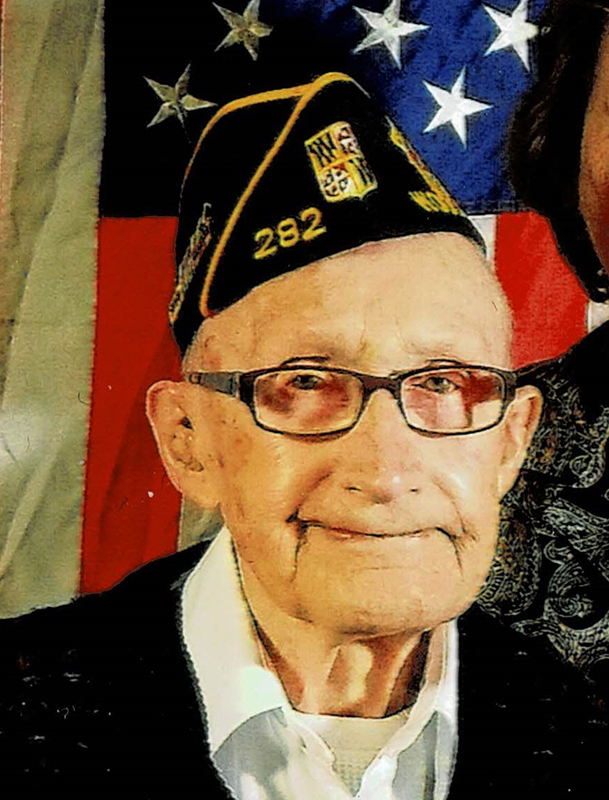by Richard D. L. Fulton
The Day Georgie Peach Helped Save 3,800 Prisoners
Walkersville may very well remember George Fisher, Sr. as a life member of the Walkersville Volunteer Fire and Rescue Company or his having been an active member of the United Methodist Church, the local Lions Club, or the Woodsboro American Legion Post.
But some 3,700 to 3,800 civilian prisoners being held by the Japanese Army in Manila during World War II might remember him for an entirely different reason: the day Fisher, aboard his tank, Georgia Peach, stormed the prison camp and helped liberate the prisoners from their brutal Japanese Army captors.
When Fisher joined the United States Army in Spring 1942 as a drummer in a regimental band with the 8th Armored Division, the raid to liberate Allied civilians being held as prisoners by the Japanese in Manila was three years away. He received his basic training at Fort Knox. A month and a half later, Fisher was sent to Fort Campbell, Kentucky, to assist in forming a regimental band as part of the 12th Armored Division. He remained there as a drummer in the regimental band and in the show and dance band.
But the frivolity, as such, was about to come to an end. In September 1943, the band was reduced in size, resulting in Fisher seeking reassignment, which landed him in the 44th Tank Battalion, a unit within the 12th Armored Division. In November, the 44th Tank Battalion was detached from the 12th Armored Division and, in March, was sent to Vancouver to prepare for deployment to the Pacific, a move that was executed in March 1944.
“We… boarded the Dutch ship S.S. Kota Baroe on March 22 and sailed unescorted for a period of 51 days before reaching our destination at Fanshawe, New Guinea,” Fisher stated in an interview.
The war officially commenced for Fisher in January 1945, when the 44th Tank Battalion was deployed along with the armed forces being sent to San Jacinto, Philippines, at the opening of the Luzon Campaign—making it the largest campaign in the Pacific war, involving more than 10 U.S. divisions.
General Douglas MacArthur, then commander of the Southwest Pacific, had become impressed with an ongoing prisoner rescue attempt and immediately ordered the formation of the “Flying Column,” with the orders to, “Go to Manila! Go over the Japs, go around the Japs, bounce off the Japs, but go to Manila! Free the prisoners at Santo Tomas…”
Fisher had been assigned to an M4 Sherman medium tank, which the crew had dubbed Georgia Peach, no doubt influenced by the fact that the tank’s commander was Sergeant Marvin Herndon, of Georgia, when orders were received to roll with the “Flying Column.”
As the column (a mere 700 men and their equipment) neared Santo Tomas, the bullets and shells began to fly, as Japanese resistance began to stiffen. Fisher described the ensuing chaos as seemingly “all Hell breaks loose, with the appearance of a fireworks display on the Fourth of July.”
Fisher stepped outside of his tank during a presumed lull and was immediately struck in the back by a fragment of shrapnel. Regarding the injury, he said, “It was red hot, and that’s why it hurt so much, but it was a clean cut,” so the tank crew “just put on a bandage,” and he resumed his position in the tank.
The troops received word that the Japanese may well have been preparing to execute as many of the civilian prisoners as they could before they could be liberated, which further hastened the American column forward. Upon orders to charge the prison compound gates, the Georgia Peach and four other tanks broke into the compound, and the fight to free the civilian captives was over… except of course, the “Flying Column” and its thousands of liberated prisoners now themselves had to escape.
The column encountered a major Japanese fortified “roadblock” while executing their withdrawal, but in 20 minutes, reduced it to rubble, and the road “home” was cleared of resistance.
Fisher was awarded a Purple Heart, a Philippine Liberation Ribbon, a Good Conduct Medal, and an Asiatic Pacific Service Medal, and served as a president of the 44th Tank Battalion Association of WWII.
Fisher, a Bedford, Pennsylvania-born, life-long resident of Walkersville, and an honorary member of the Bay Area Civilian Ex-Prisoners of War, which had been bestowed upon him as a result of his participation in the 1945 rescue of the 3,800 civilians at Santa Tomas, passed away at the Montevue Assisted Living in Frederick, on July 11, 2000—23 days after his 100th birthday.

Corporal George Fisher, Sr. Courtesy of Family

George Fisher, Sr. and Georgia Peach. Source: Citations Magazine

